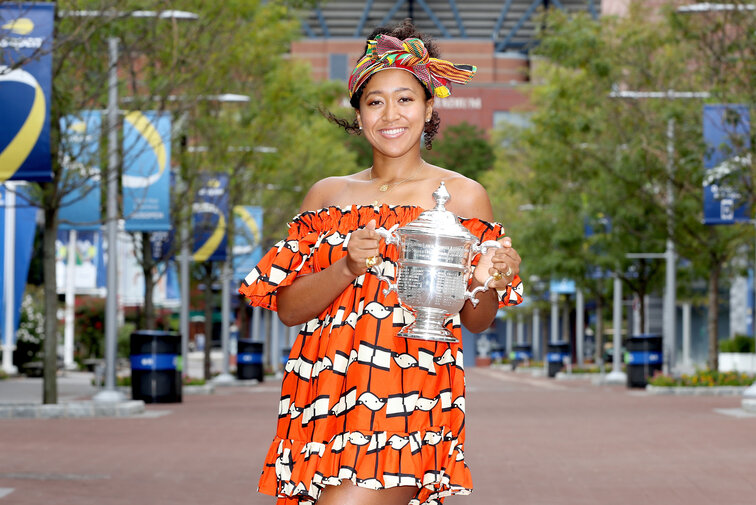US Open winner Naomi Osaka continues to gain shape
Naomi Osaka doesn't want to be different. She is just different from the others in the migrant tennis circus. It was the same again in her last big hour, in the hour of her third Grand Slam victory in the third Grand Slam final.
by Jörg Allmeroth
last edit:
Sep 14, 2020, 12:26 pm

A good minute had passed after her 1: 6, 6: 3, 6: 3 win over Viktoria Azarenka, when the 22-year-old Japanese spread out on the hard Center Court floor very carefully and by no means impulsively. Osaka looked up to the skies above New York and when you later asked why she did that, you got the amazing answer: “I have often seen the great players sink to the ground after their victories. I've always wanted to see what they saw. "
Osaka is an extraordinary figure in the professional, at first glance glamorous entertainment business, in the dazzling tennis business between appearance and reality. And it almost fits her involuntary special role that she triumphed for the second time under the strangest conditions in the US Open biotope. First in 2018, as a victorious supporting character during Serena Williams' murder theater in the roaring arena. Well, in September 2020, as the winner of the Ghost Grand Slam, in an orphaned stadium in which the emotions were only generated by the main actresses themselves. Osaka seemed to be facing a grotesque doom at first, almost listlessly she wandered around in the largest, almost deserted tennis stadium in the world. Then, however, after a 1: 6, 0: 2 deficit, she unfolded her incomparable power and game intelligence, turning the game around apparently without any effort. “At some point I thought it would be embarrassing to lose this game under an hour.” So she just won it as if nothing was easier in this Grand Slam universe.
"What message did you get?"
Osaka has the talent to shape, if not dominate, women's tennis of the future in the first place. At the same time, as a wide-awake personality, she has long since transcended the boundaries of her professional world, her voice on social problems, which is rarely but more effectively used, is being heard more and more. She recently explained her self-image in a memorable way in a film: “Just because I'm calm doesn't mean I have no influence. Just because I'm humble doesn't mean I'm not confident. "
At the US Open, she came to her seven appearances with a different mask in the stadium, always the name of a black victim of arbitrary police violence was printed, in the final that of the 12-year-old Tamur Rice, who was shot in Cleveland in 2014. After the final, ESPN interviewer Tom Rinaldi asked the winner what she wanted to achieve with this campaign. Osaka replied: “What message did you get?” A little later, she explained her mission as follows: “I want people to talk about this topic.” About a topic that she experienced firsthand, she finally drew The Osaka family once moved from Japan to America because mother Tamaki's marriage to a Haitian was considered a "disgrace". The children, Naomi and Mari, were called "Hafu", "half-Japanese".
Osaka remains Osaka
In the first few years in professional tennis, Osaka always seemed a bit unfathomable, mysterious, sometimes even remote from the world. But she has always been one of the most exciting figures on the scene, a sports executive like no other. But almost to the same extent that she got the challenges on the grueling tour more confidently under control, and was not deterred by setbacks, she also matured to unmistakable, unmistakable size and strength. “Many tend to underestimate them,” says the legendary old master Martina Navratilova, “despite all the successes. Despite everything she does. "
Even if many tug at her and want something from her, whether sponsors, the media, the players' union, tournament organizers or, more recently, political actors - Osaka, this girlish appearance with the striking black corkscrew curls and the bronze-colored complexion, has always remained Osaka. Gone are the days when Osaka was believed to be a piece on a chessboard pushed around by powerful influencers. Often enough, she herself decides where to go. For example at the Masters tournament in Cincinnati, which was held in New York the week before the US Open. Osaka joined the protests in US sports - after the scandal surrounding the seriously injured Jacob Blake, who was shot seven times in the back by police officers - and refused to appear in the semi-finals. With the consequence that the entire game plan was canceled by the tennis officials involved.
When Osaka was once included in the list of the 100 most influential people in the world by “Time” magazine, she reacted with embarrassment: “I have no idea why that is.” That has also changed, especially for the world beyond the Center Court .
